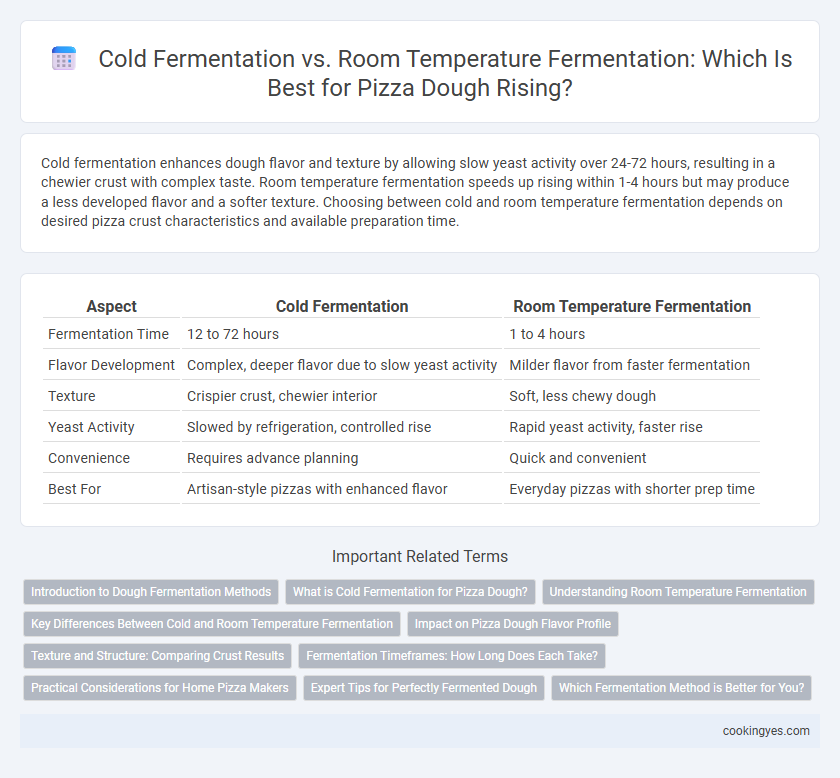Cold fermentation enhances dough flavor and texture by allowing slow yeast activity over 24-72 hours, resulting in a chewier crust with complex taste. Room temperature fermentation speeds up rising within 1-4 hours but may produce a less developed flavor and a softer texture. Choosing between cold and room temperature fermentation depends on desired pizza crust characteristics and available preparation time.
Table of Comparison
| Aspect | Cold Fermentation | Room Temperature Fermentation |
|---|---|---|
| Fermentation Time | 12 to 72 hours | 1 to 4 hours |
| Flavor Development | Complex, deeper flavor due to slow yeast activity | Milder flavor from faster fermentation |
| Texture | Crispier crust, chewier interior | Soft, less chewy dough |
| Yeast Activity | Slowed by refrigeration, controlled rise | Rapid yeast activity, faster rise |
| Convenience | Requires advance planning | Quick and convenient |
| Best For | Artisan-style pizzas with enhanced flavor | Everyday pizzas with shorter prep time |
Introduction to Dough Fermentation Methods
Cold fermentation involves fermenting pizza dough at temperatures between 39degF and 45degF (4degC to 7degC) for an extended period, typically 24 to 72 hours, enhancing flavor complexity and improving dough texture. Room temperature fermentation occurs at approximately 70degF to 75degF (21degC to 24degC), allowing dough to rise more quickly within 1 to 3 hours, which can produce a lighter, airier crust but less developed taste. Both methods rely on yeast activity to produce carbon dioxide and organic acids, crucial for dough expansion and flavor development during the fermentation process.
What is Cold Fermentation for Pizza Dough?
Cold fermentation for pizza dough involves allowing the dough to rise slowly in a refrigerator at temperatures between 38degF and 45degF (3degC to 7degC) over 24 to 72 hours. This process enhances flavor development by promoting the growth of organic acids and yeast activity, resulting in a more complex, tangy taste and improved dough texture. Cold-fermented dough also offers better gluten structure and easier handling compared to room temperature fermentation.
Understanding Room Temperature Fermentation
Room temperature fermentation allows pizza dough to rise faster, typically within 1 to 3 hours, due to ambient temperatures between 70degF and 75degF (21degC to 24degC). This method accelerates yeast activity, resulting in a softer texture but less complex flavor compared to cold fermentation. Many pizzaiolos prefer room temperature fermentation for quick preparation while still achieving a tender crust.
Key Differences Between Cold and Room Temperature Fermentation
Cold fermentation occurs at temperatures between 35degF to 50degF, slowing yeast activity and allowing for extended dough rising times up to 72 hours, which enhances flavor development and dough texture. Room temperature fermentation typically happens between 68degF to 75degF, resulting in faster yeast activation and quicker dough rising within 1 to 3 hours, producing a lighter crust with a softer crumb. The key differences lie in fermentation duration, temperature control, yeast activity rate, and the resulting flavor complexity and dough structure.
Impact on Pizza Dough Flavor Profile
Cold fermentation enhances pizza dough's flavor profile by allowing extended enzymatic activity, producing complex and tangy notes with a subtle sweetness. Room temperature fermentation develops faster yeast activity, resulting in a milder, less developed flavor and a more straightforward dough character. The choice between cold and room temperature fermentation significantly influences the depth, aroma, and texture of the final pizza crust.
Texture and Structure: Comparing Crust Results
Cold fermentation enhances gluten development and moisture retention, resulting in a chewier, more complex crust with a slightly tangy flavor. Room temperature fermentation produces a softer, airier crust due to faster yeast activity and quicker gas formation. The choice influences crust texture and structure, with cold fermentation favoring a denser, more robust bite and room temperature yielding a lighter, more delicate crumb.
Fermentation Timeframes: How Long Does Each Take?
Cold fermentation for pizza dough typically takes between 24 to 72 hours, allowing yeast to develop complex flavors and improve texture through slow metabolic activity at temperatures around 4degC (39degF). Room temperature fermentation, in contrast, generally requires 2 to 6 hours at approximately 21degC (70degF), resulting in faster yeast activity but less nuanced flavor development. Extended cold fermentation produces dough with enhanced elasticity and a chewier crust, while shorter room temperature fermentation yields a softer, more immediate dough rise.
Practical Considerations for Home Pizza Makers
Cold fermentation at 4degC over 24-72 hours enhances dough flavor and texture by slowing yeast activity, allowing complex gluten development ideal for artisanal pizzas. Room temperature fermentation at 20-25degC speeds up rising, requiring 1-3 hours, suitable for quick pizza preparation but with less nuanced flavor profiles. Home pizza makers should balance time constraints, available space, and desired dough characteristics when choosing between cold and room temperature fermentation methods.
Expert Tips for Perfectly Fermented Dough
Cold fermentation slows yeast activity by fermenting pizza dough in the refrigerator at 40degF for 24 to 72 hours, enhancing flavor complexity and gluten development. Room temperature fermentation, typically conducted at 70-75degF for 2 to 4 hours, allows for faster yeast activation and quicker dough rising but may sacrifice depth of taste. Experts recommend cold fermentation for artisanal dough with a chewier texture and richer flavor, while room temperature fermentation suits quick recipes, and they advise controlling hydration levels and using quality flour to optimize fermentation results.
Which Fermentation Method is Better for You?
Cold fermentation enhances dough flavor and texture by allowing slow yeast activity over 24 to 72 hours at temperatures around 4degC, resulting in a chewier crust and more complex taste. Room temperature fermentation, typically lasting 1 to 3 hours at around 21degC, offers faster proofing but produces a milder flavor and softer texture. Choosing between cold and room temperature fermentation depends on your schedule and preferred pizza crust characteristics, with cold fermentation favored by those seeking depth of flavor and room temperature fermentation suited for quick preparation.
Cold Fermentation vs Room Temperature Fermentation for Dough Rising Infographic

 cookingyes.com
cookingyes.com